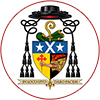South wall of the Transept Aisles
Passing through a communicating door, the visitor enters the original Transept chapels - now for the time being, combined to form one chapel of which the most distinguished feature is the fine groined roof. This again shows vestiges of polychrome decoration, and it requires quite an effort of the imagination to clothe the present-day stone with the brilliant colour that it must once have borne. In these two aisles there is also the same contrast between the plain treatment of the north and the decorativeness of the south that we saw in the Transepts themselves, and in the later work of the south aisle there is a wealth of interest and excitement in the unexpectedly vivid carving and ornamentation of the architectural detail. The east walls of these aisles must originally have formed the reredos behind the altars of the side chapels, and it is no surprise therefore to find faint survivals of mural decorations here too; at the south-east corner the subject matter can perhaps be identified as a portrayal of St. John the Baptist.
At this south end of the Transept Aisles a squint allows a view of the altar of the Lady Chapel and may have been inserted here after the fire of 1390. The walls of this squint also are covered with fresco and the small columns on either side are worthy of notice for their curious asymmetry, two having plain capitals, another carved with foliage and the fourth with the figures of two angels.
Before we leave the aisles we should notice the fine stained glass window on the themes of The Visitation and The Lamb of God.
